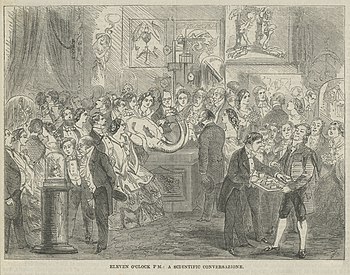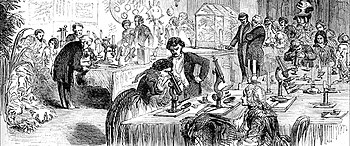Conversazione

Content
Origem
O escritor Horace Walpole é creditado com o primeiro uso em inglês registrado de Conversazione em uma carta escrita (da Itália) em 11 de novembro de 1739 para Richard West (1716-1742), no qual ele escreve: "Após a peça que fomos apresentados à Assembléia, que eles [a saber, os italianos] chamam de Conversazione ".
Uso histórico na Grã -Bretanha

Na Itália, o termo geralmente se refere a uma reunião para conversar; e foi usado pela primeira vez em inglês para identificar o tipo de reunião social privada mais conhecida hoje como um "em casa".
Na Inglaterra, no entanto, logo passou a ser muito mais usada para denotar as reuniões de um caráter muito mais intelectual e foi aplicado no sentido mais específico de uma Assembléia/Soirina científica, artística ou literária, geralmente realizada à noite.
A conversazione like everything else has undergone conspicuous development in these days.Formerly the word was applicable only to a meeting of cognoscenti, who were themselves proficient in some art or science which might be the immediate subject of learned interest.At the present time the materials for discussion are supplied by the proficients, and the general public are invited to provide the talk or the criticism.Moreover a "conversation" of this kind is not limited to a specific subject, but may comprise topics incidental to any branch of science and art whatever. (New Zealand Herald, 17 September 1880.)Em seu relatório sobre a primeira Conversazione já realizada pela Instituição Literária Lambeth (em 22 de junho de 1836), a revista Gentleman observou que,
the principal object [of the Lambeth Literary Institution's inaugural conversazione] has been—by the collection of articles of virtù, antiquity, science, or art, and by the reading of original papers, conversation, and music,— to unite its members, at stated periods, into one focus of neighbourly community; where all may be on a footing of social equality,—the aristocracy of mind, united with urbanity of manners, alone maintaining its ascendancy here; where the high attainments of the classical scholar,—the lofty imaginings of the poet,—the deep researches of the man of science,—and the sturdy intelligence of the skilful artizan [sic], may all be amalgamated under one roof; and the rough energies of manly intellect be thus softened and refined by the amenities of the social circle.Disseminação do conhecimento
Segundo Yeates (2018):
In Victorian England, the conversazione was one of the most important educational, cultural, and recreational means through which scientific knowledge was disseminated and explanations of technical innovation were delivered to the general public.Conducted by individuals, institutions, or learned bodies, a (usually mixed amateur/expert, male/female) audience was enlightened by explanations, two-way interactions with participants, experiments, demonstrations, hands-on displays of equipment, and/or the exhibition of specimens (see Alberti, 2003; and Plunkett & Sullivan, 2012).The conversazione’s lectures/explanations delivered knowledge by description, and its experiments, demonstrations, hands-on displays of equipment, and exhibition of specimens delivered knowledge by acquaintance (with the concomitant psychological ownership of the knowledge so-acquired).Outros usos
Universidade de Cambridge
The intellectual society at Cambridge University known as the Apostles was founded in 1820 as the Conversazione Society by George Tomlinson.The Cambridge University Natural History Society continues to call its annual public exhibition a Conversazione.Vivazione.org
O site de mídia social orientado a artes conversazione.org recebe o nome do significado em inglês.






